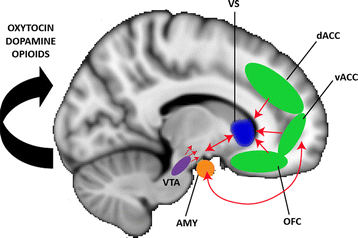Motivation
From Deliberative Democracy Institiute Wiki
|
This page is a stub. It is not ready for publication and is used to aggregate information about a subject. You can add further reading and add information to the page. If you want to prepare this page for publication please consults with the creator of this page. |
The Ventral Stratium is positivly corrlated with effort, and thus it is sought to be involved in motivation[1], and also the rACC[2][3]
The neural circuitry of reward ‘wanting’ versus reward ‘liking’. The neural circuitry of reward ‘wanting’ comprises the ventral striatum (VS; blue), while that for reward ‘liking’ comprises the vmPFC, including the orbitofrontal cortex (OFC) and the dorsal and ventral anterior cingulate cortex (dACC, vACC) (green), which closely interacts with the amygdala (AMY = orange) and the midbrain, including the ventral tegmental area (VTA; purple). This complex network interfaces with motor-related areas and other higher cognitive associative cortices (not shown here) to translate basic reward information into appropriate goal-directed action plans to achieve a desired reward[4].
The ventral striatum fulfilled all three criteria and therefore qualified as a common motivational node capable of driving both cognitive and motor regions of the dorsal striatum[5].
A need for action may be modulated by dopamine[6]
See also
Brain mechanismes for motivation (2012)
References
- ↑ Mechanisms Underlying Motivation of Mental Versus Physical Effort. PLoS Biology, 2012; 10 (2): e1001266 DOI: 10.1371/journal.pbio.1001266. (for breif review read on ScienceDaily)
- ↑ http://www.ncbi.nlm.nih.gov/pmc/articles/PMC3044650/#R2
- ↑ Todorov, Alexander, Susan Fiske, and Deborah Prentice, eds. Social neuroscience: Toward understanding the underpinnings of the social mind. Oxford Scholarship Online, 2010.
- ↑ from: Kohls, G., Chevallier, C., Troiani, V., & Schultz, R. T. (2012). Social “wanting”dysfunction in autism: neurobiological underpinnings and treatment implications. Journal of Neurodevelopmental Disorders, 4(10), 1–20.
- ↑ Schmidt, L., Lebreton, M., Cléry-Melin, M.-L., Daunizeau, J., & Pessiglione, M. (2012). Neural mechanisms underlying motivation of mental versus physical effort. PLoS Biology, 10(2), e1001266.
- ↑ [http://www.sciencedirect.com/science/article/pii/S0166223607000665 M. Angela Cenci, Dopamine dysregulation of movement control in l-DOPA-induced dyskinesia, Trends in Neurosciences, May 2007, Vol.30(5):236–243, doi:10.1016/j.tins.2007.03.005]
